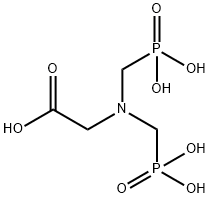Glyphosine , Analysis standard , 2439-99-8
Synonym(s):
N-(Carboxymethyl)iminodi(methylphosphinic acid);Glyphosine
CAS NO.:2439-99-8
Empirical Formula: C4H11NO8P2
Molecular Weight: 263.08
MDL number: MFCD00056670
EINECS: 219-468-4
| Pack Size | Price | Stock | Quantity |
| 100MG | RMB31.20 | In Stock |
|
| others | Enquire |
PRODUCT Properties
| Melting point: | 263°C |
| Boiling point: | 668.4±65.0 °C(Predicted) |
| Density | 1.952±0.06 g/cm3(Predicted) |
| storage temp. | +2C to +8C |
| solubility | PBS (pH: 7.2):5.0(Max Conc. mg/mL);19.01(Max Conc. mM) |
| form | Solid |
| pka | pK1 1.42; pK2 2.10; pK3 5.02; pK4 6.40; pK5 11.19(at 25℃) |
| color | White |
| Water Solubility | 248g/L(20 ºC) |
| Merck | 13,4526 |
| BRN | 1884944 |
| CAS DataBase Reference | 2439-99-8(CAS DataBase Reference) |
| EPA Substance Registry System | Glyphosine (2439-99-8) |
Description and Uses
Glyphosine was introduced in 1973 and is preferably used in sugar beets. The synthesis starting with glycine uses two equivalents of formaldehyde and of phosphorous trichloride under oxidative conditions. A second derivative of Glyphosate is a cyclic phosphaoxazole being formed from Glyphosate and formaldehyde. This compound is claimed to control the growth of some grasses without dis- coloration or phytotoxicity.
Application: Complexing agent; pK-values: pK1: ·2, pK2: 2.0, pK3: 5.20, pK4: 6.77, pK5: 10.89
Anti-diabetic; delay onset of diabetes in non-obese NOD mice
Glyphosine binds to a pocket of MHC class II molecules I-Ag7 and DQ8, and modify T cell responses to the autoantigenic insulin B chain fragment 9–23 (B:9–23) peptide. Glyphosine stimulate IL-10 production and delay onset of diabetes in non-obese NOD mice.
Safety
| Symbol(GHS) |  GHS05 |
| Signal word | Danger |
| Hazard statements | H318 |
| Precautionary statements | P280-P305+P351+P338+P310 |
| Hazard Codes | Xi |
| Risk Statements | 41 |
| Safety Statements | 26-2 |
| RIDADR | UN 3261 8/PG 3 |
| WGK Germany | 1 |
| RTECS | MB9120000 |
| HS Code | 2922.49.8000 |
| Toxicity | LD50 orally in rats: 3925 mg/kg; dermally in rabbits: >5010 mg/kg (Ahlrichs) |


